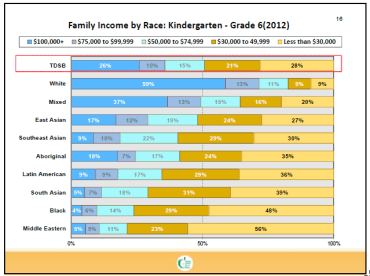Poverty is a desperate, sad thing. It damns us all, but hurts some of us even more.
Single mothers face twice the poverty rate of couples with children. New immigrants, First Nations people and People of Colour find the labour and housing markets exclude them in very similar and harsh ways. Youth now enter a re-shaped labour market with limited prospects for success. People travel further within Toronto for poorer jobs, bad food and scarce housing. These are terrible awful things which we all well know.
So, then…
As the great Torontonian Ursula Franklin reminded us, “After you have finished awfulizing, then what?”
On March 17, the City of Toronto’s Community Development and Recreation Committee considered a motion to develop a strategy to address poverty. The motion passed and is the April agenda at City Council.
Last fall, the Alliance for a Poverty-free Toronto (APT) produced a report, delivered to every City Councillor, which builds a strong case for change and then points the way. This second half of the report, the call for action, offers some possibilities for the conversation which is about to begin. In it, the Alliance put forward some very specific recommendations for many of the ‘wicked’ problems which face low-income people.
The APT report, Towards a Poverty Elimination Strategy for the City of Toronto, calls for actions in the areas of:
1. Employment (e.g. living wage policy, stronger employment equity, paid internships for youth and newcomers, advocacy for a provincial/national jobs strategy)
2. Income support (advocacy for more adequate provincial income support programs and improved access to Employment Insurance)
3. Housing (address provincial wait list, TCHC repairs, inclusionary zoning, upgrade shelter services, enhance Housing Stabilization Fund)
4. Transit (increased operating support for TTC, barring fare hikes, discounting transit passes for low-income residents, advocacy for adequate provincial funding)
5. Community Services (increased access to mental health, addictions, disability supports; better funding for non-profit and community organizations, better access to affordable child care)
APT also offered a few broad recommendations:
► The first is that a coordinated approach to addressing poverty is needed. In poverty, problems are complex and intertwined, so one-off solutions will not work.
► The second is that every decision brought before Council requires a poverty lense to be used – will the recommendation being considered make poverty better or worsen it? How can the decision under discussion improve the lot of those without? This strong core is required to make a change.
It seems now that strategies are sexy, the new way for governments to respond, to demonstrate their commitment to respond. Last month the Director of Poverty at the Rowntree Foundation in the U.K. posted a cynical blog post about a new Child Poverty strategy. A strategy has to be more than priorities, he cautioned, but connect to specific targets and spark action; otherwise it is simply window-dressing.
The time for action is now. Why? Here’s why:
In an anecdote about his childhood, Mayor Naheed Nenshi explains the difference a city can make. He explained, that while he was from a low-income family, they were not poor. The library with any book he wanted was up the street, the City pool was down and around the corner. For him, downtown was an easy transit ride away. At school, he would have enjoyed a daily snack (something particularly poignant in Toronto given the recent testimony by a pediatric nutritionist on how the school snack program saved Jeffrey Baldwin’s sister from starvation).
Poverty is not inevitable, but it is a choice, of our own economic and social priorities. The City has a chance to make a difference.
This is a version of a text delivered earlier as a deputation by APT for a municipal poverty reduction strategy. A version is cross-posted at Opportunity blogs here.



